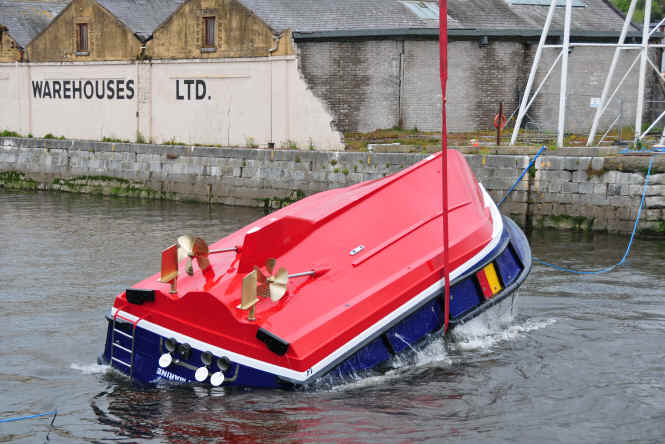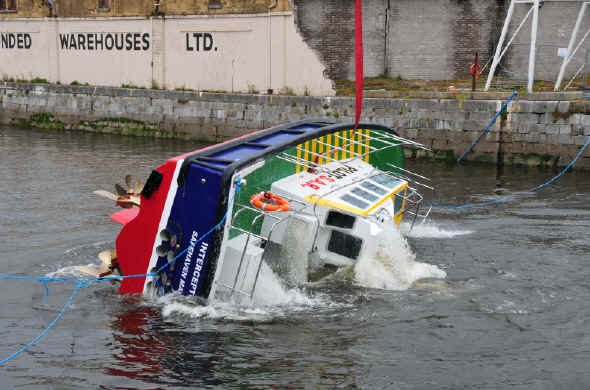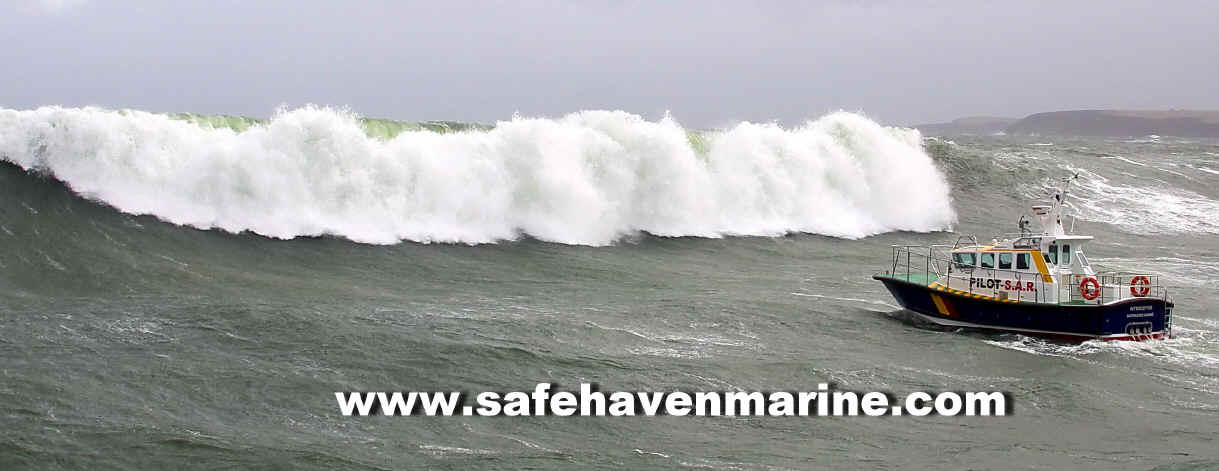
PILOT
BOAT DESIGN AND MANUFACTURE, A BUILDERS PERSPECTIVE.
Paper presented to the IMPA Pilots convention in London 2012. Paper written by Frank Kowalski, Managing Director of Safehaven Marine.
Photo
below, Safehaven Marines Interceptor 38 Pilot squaring up to a big sea.

Contents
Background
to Safehaven Marine.
Safehaven Marine are specialist pilot boat
manufacturers, we build around 6-7 pilot vessels per year and 80% of our
production is specifically dedicated to pilot vessels. This means we have
amassed a great deal of experience in this specialized area, and have supplied
over 25 pilot vessels to ports worldwide and our Interceptor range of pilot
vessels has renowned reputation for their sea keeping abilities.
Pilot
boat

Since the
1970's, a period which saw the archetypical Nelson become the standard pilot
boat design, with its traditional slim, round bilge hull, built predominantly in
GRP, it dominated the market for a great many years, and provided sterling
service throughout the world, with very little competition.
The
majority of new modern designs have been based around the medium to deep V, semi
or fully planning chine hull design, in various forms. This design has proved to
offer advantages over the traditional round bilge hull form which, whilst being
very good into a head sea, is very wet, which can compromise visibility, and it
lacks the dynamic stability of modern 'V' hull designs, when running down wind
in big following seas at speed. The
round bilge hull also lacks the 'V' hulls greater stability beam on to the sea,
as well as during boarding man oeuvres, during which the latter, with its wide
beam and chines offer greater stability as well as dryness, both important
considerations for the pilot during transfer. Comparing like for like at similar
displacements, the planning 'V' hull has the potential to go faster in the
higher speed ranges, although at typical 23-25kt
pilot boat operational speeds, the easily driven round bilge, semi-displacement
designs can be its equal. Modern hull designs also typically feature either a
full length keel, or a deep skeg, both give the advantage of protecting the
stern gear and allow the vessel to beach, as well as providing good directional
stability at slow speeds in rough
weather. If speeds over 30kts are required then invariably the keel is omitted,
as it tends to work against the hull at high speeds. On modern 'V' hull planning
designs the use of adjustable trim plates can be very beneficial and allow the
helmsman to lower running trim for head sea work, and here in combination with
sharp forward sections can be very effective in providing a soft ride that can
be equal of a round bilge design.
Sea
keeping. Light weight / economy vs sea keeping
There is a
trend to try to go for lightweight pilot vessel designs to improve speed and
economy, and whilst endeavors in this respect are always valuable, the two
factors of light weight and sea keeping abilities can be can sometimes be
mutually exclusive. Having built as example, over 40 of our Interceptor 42's in
various displacements ranging from 9 tons to 16 tons, and having helmed them all
in heavy weather, I can confirm that there is a big difference in sea keeping
abilities between the two displacements. The combination of a good displacement,
combined with a very low centre of gravity is simply unbeatable in the rough,
giving much less lively motions. The heavier displacement is also especially
noticeable in head seas, allowing the vessel to push through the waves with less
tendency to become airborne. Light
weight designs are very suitable for working inside the harbour in sheltered
waters, but simply can not offer the same comfort and security to pilots
offshore in rough conditions.
Below,
Safehaven Marines Interceptor pilots operating in rough conditions
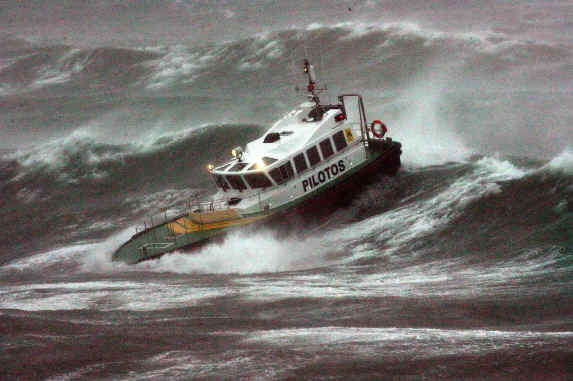
Aluminium
vs steel vs GRP, the choice.
GRP
construction on pilot boats has in the
GRP can sometimes be considered 'lightweight' in its construction, probably as a result of the large percentage of recreational vessels built in GRP. However, professional GRP commercial vessels are in fact quite the opposite, being very heavily constructed. As example, our pilot vessel hull has its strength increased locally at high stress areas, in fact the hull bottom thickness of our vessels can exceed 30 millimeters, (compared to 6-8 millimeters on similar sized aluminium vessels). This allows the builder to make the vessel exceptionally strong where it counts.

4/
Pilot boat Fendering solutions
There are several types of fendering systems used on
pilot boats. They can be summarized in 3 main types:
First is the Traditional D section rubber
fender, through bolted and bonded to the hull.
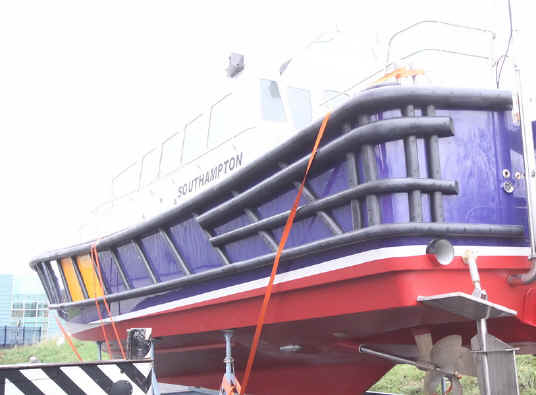
Secondly the excellent French
NIBs or Ocean 3 systems, which features a 3-400 millimeter round foam
cored with a rubber skin that is retained in a grove formed in the hulls side,
and secured with multiple straps, most commonly used in the French market.
Below the excellent 'Ocean III' fendering system
on the
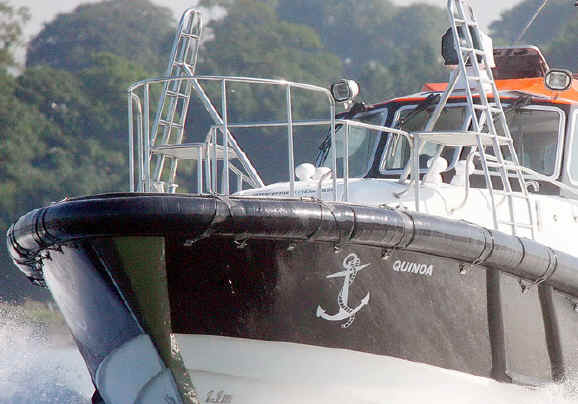
Thirdly the Lightweight, foam cored rubberized skin type, which is bonded to the hull with silkaflex and fourthly, the Pop Sure system, as above but which is formed with a grove, into which sits a hard plastic tube, held in place with a tensioned wire running through it.
We can offer, and have fitted most of the available
fendering options on our pilot vessels over the years, and can briefly summarise
the advantages and disadvantages of the various types as follows.
D section rubber fender. This is the most
commonly used fendering system, proven over the years
Cost, it is by far the cheapest type.
Durability. Being thick walled, generally 25-50mm it
resists damage well. Being through bolted it is relatively easy to repair, and
repair can be carried out quickly, as sections are generally available ex stock
from the manufacturer.
Imparts more stress on the hulls structure in impacts
it is the heaviest in weight
The lightweight, rubber skin, polyethylene foam type
systems.
Advantages
Being Lightweight, these systems reduce the vessels
weight, potentially increasing the speed of the vessel, although this can be
somewhat negated on the types retained with straps due to the numerous necessary
deck & hull fittings.
All offer better impact absorption, imparting less load
on hull structure.
Disadvantages-
All systems are significantly more expensive, between
six to ten times the price of rubber fender. All have to be custom made for the
specific vessel, meaning if a section is damaged, repair will be slower, unless
spare sections are stocked by the port.
Durability, some systems are more durable than others,
but with all the outer rubber skin is not as thick as rubber fendering, and as a
result, can more easily ripped or punctured by sharp protrusions on the ship
side.
The Pop Sure system bypasses these disadvantages as it
is the hard plastic tube that impacts with the ship.
In making a decision, the significant cost differential
of the alternative systems must be weighed up against their advantages and
disadvantages, when deciding on which system is to be used by the port. It can
be difficult to beat rubber D section, it is the most commonly used
fendering system, it is the cheapest, and it is easy to replace a damaged
section quickly.
Specifically in respect of Safehaven Marine we have our
own 'Sacrificial fender system' which we have uniquely developed and is used
with rubber 'D' section fendering. It has been fitted to pretty much all our
pilot vessels over the years, it is well proven in service and gives the best of
both worlds. The sacrificial fender fits over the 'D' section like a glove, and
is retained with straps. It provides soft impacts, protects the main fendering.
It is cheap, durable and quickly replaced, (a 3m section costs only a few
hundred euro), and the straps and fittings are of no significant cost.
Below, Safehaven Marines special sacrificial
fender.
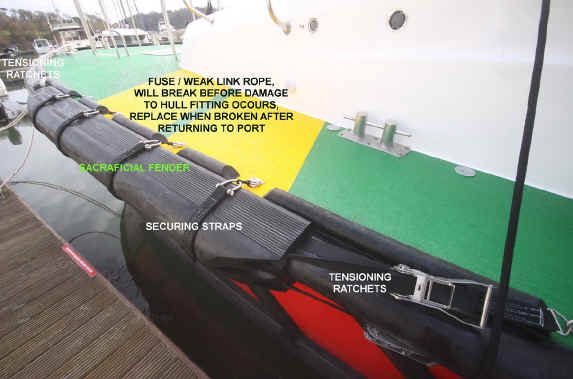
Propulsion
systems
Predominantly,
it is conventional stern gear that is the preferred propulsion system. The only
other viable option is water jets.
Water jets.
Assuming
that the operator is fully trained and experienced in the operation of water
jets, it is amazing what the vessel can be made to do at slow speed maneuvers.
However the caveat being that the operator must be experienced in the use of
water jets, trying to introduce water jets to a port where the operators have
been used to props would, I imagine, be fraught with difficulties, and met with
much resistance.
Another
advantage of water jets is the low noise and vibration levels that are achieved
,as well as shallow water capabilities (although rarely an issue in modern
ports) as well as safety in casualty recovery from the water. However against
these advantages, consideration must be given to the fact that water jets have
significant disadvantages. At the slower speeds pilot vessels generally operate
(23-25kts), jets are less efficient, only coming to their own above 30kts. At
mid range speeds of 17-20kts, they are less efficient than propellers. In
rough weather, especially in following seas when say, trying to climb the back
of a big wave, they can overload and bog down. You can in this situation find
yourself slowing right down and falling off plane, then having to wait for the
wave to pass before the boat can regain speed surfing on the face of the next
wave, at which times the lack of directional stability that comes from not
having a deep keel or rudders, which means constant work on the helm. In these
conditions a prop boat will just chug on through the waves. With water jets,
trying to keep a straight course at slow speeds in cross winds can also be a
real challenge. Finally the initial purchase cost must be considered, like for
like a water jet system costs around 7 times the price of a set of conventional
stern gear. Also maintenance costs for water jets are much higher.
Conventional sterngear. This is the most common system of propulsion on pilot vessels and is hard to beat for its all round effectiveness. Its main disadvantage over jets is the increased draft, susceptibility to damage from floating debris and increase noise levels however in so many respects it is superior offering virtually no maintenance, excellent directional stability and capabilities in rough conditions, its efficiency at transition speeds of 17-20kts is very good and factoring the price difference it is hard to beat and easy to understand why, for the vast majority of applications it is the obvious choice.
Pilot
safety, Pilot boarding ladders, pros & cons
The use of
Pilot boarding ladders in their various forms is quite divergent. In some
countries they are the norm, whilst elsewhere they are rarely used. In my
experience they appear universally favored in
The
advantage of the ladder is that it reduces the risk of the pilots foot becoming
trapped between the pilot boats deck and the ships side, as it places the pilot
clear of the impact area. The ladder, by its nature, also provides many more
surfaces to grab and hold onto than just a single railing. The disadvantage is
that the pilot is subjected to higher motions when on the ladder by being
elevated 1m above the deck. These motions can be quiet high in rough weather.
There is of course the risk that in a big roll, the pilot could be crushed
between ladder and ship, however platforms at the back of the ladder allow the
pilot to quickly to duck clear. Still, I imaging that this is the biggest
concern.
As a result
the pilot ladder is more likely to be used in calm to moderate boarding
conditions, and not so often used in rough conditions, however, ironically, it
is most likely only in rough conditions that foot injury is likely to occur, the
prevention of which is the ladders primary purpose. As well as adding top
hamper, the ladders do restrict f/wd visibility, although not as badly as one
might think, and I imagine the debate on whether to fit pilot ladders or not,
will continue.
Below, left an example of a pilot boarding ladder fitted to one of our Interceptor 48 pilots,
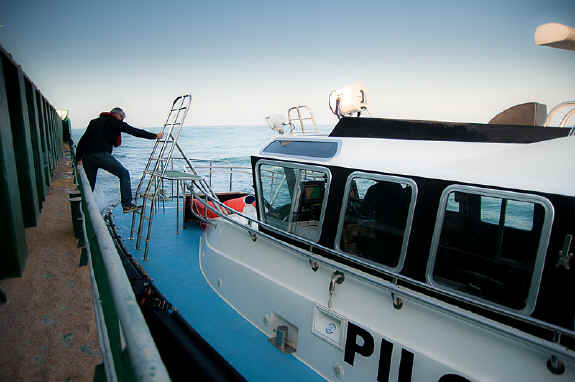
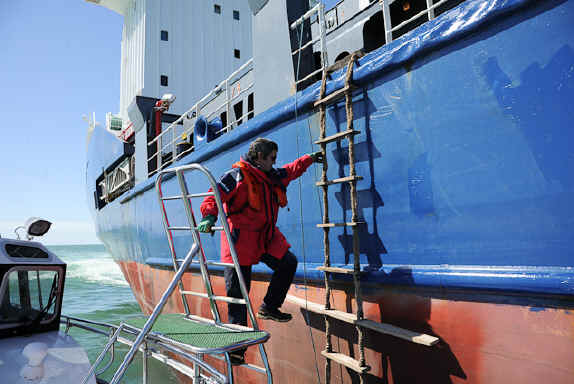
MOB
recovery systems
Most
important on a pilot boat is the consideration for safe and quick pilot
recovery, should he accidentally fall or be swept overboard whilst boarding a
ship. We have developed our own transom mounted fixed M.O.B. recovery platform,
which has been used in anger in a real life incident, to recover a pilot. Feed
back we have received over the years has allowed us to refine the system. We
have also fitted the 'Jasons Cradle' recovery system as well. I can impart some
opinions about both. The advantage
of a well designed, fixed transom recovery platform being that it is instantly
deployable, it should extend at least 400mm below the waterline to ensure it
stays submerged even in surge and roll, it should also have no sharp edges. As a
further refinement our system can be integrated with a prop guard that drops
down, and will help in preventing the casualties legs from coming near the boats
propellers. Special attention needs to be paid to the lifting system used, be it
manual winch or hydraulic. If manual, it should be born in mind that a large wet
casualty will weigh a considerable amount, the winch needs to have a suitable
ratio, or a double or triple pulley system to reduce the lifting force on the
person operating the winch. One disadvantage of stern platforms is that
invariably the vessel drifts beam on to the wind, therefore when allowing the
vessel to drift down to the casualty, securing the casualty can be difficult. A
Matesaver, or even a boat hook is essential for recovery. Another
consideration is visibility for the helmsman if backing down towards the
casualty, good rearward visibility is essential, rear view cameras can be
incorporated to assist him. However the ideal solution, one which we have used
regularly is that of a second aft helms station positioned on the rear of the
cabin, this allows the helms man good visibility and control of the vessel
during recovery. This brings us to the Jason's cradle system, the main advantage
of which is that the casualty can be recovered from a midships position, clear
of the props and the vessel can be better oriented for drift. From
this position the helmsman invariably has clearer visibility of the casualty
during recovery, which is an advantage. Bellow
Safehaven's MOB pilot recovery platform during trials.
The Jason's cradle should ideally be stored in a locker at the recovery position, allowing it to be quickly deployed, and when correctly operated it can be very effective. One disadvantage of the system however is the necessity for ropes and pulleys that need to be connected, which takes valuable time, and can invariably become entangled. This can present difficulties, especially considering the stress the operator could be under at night in rough conditions. Whichever system is chosen training and practice drills should be regularly carried out to ensure all crew members are familiar with the recovery procedures. Below, Jasons cradle system.
Helm
design, Seats & ergonomics
Nowadays, a
central helm position is favored on most modern pilot vessels. This gives the
advantage of equal visibility for the helmsman when coming alongside either to
port or starboard. The helm position should be ergonomic in design and should
feature 4x4 jeep or van like seat / wheel positioning, by this I refer to a near
horizontally orientated wheel, which should be adjustable for angle. The foot
rest should be large and wide allowing the helmsman to brace himself in rolling,
not just be a step or rail that the helmsman feet can easily slip off in rough
weather. Throttles should be within reach without stretching as should regularly
used controls such as wipers, trim tabs and radio mic, allowing the helmsman to
instinctively lay his hand on the controls, without searching them out. All
navigation instruments should be easily visible, without being obscured by the
wheel, a common oversight. It is best to minimize the switches close to the
helmsman to only often used essential systems, i.e. nav lights, deck lights and
such forth, and to avoid overly cluttering the immediate helm position to minimizing
confusion.
Suspension
seats for crew and pilots are essential, and seat belts are a good idea,
although whether they ever get used is another matter. We have found that air
suspension seats, although more costly do offer the best ride. Assuming adequate
space, a table in front of the seat can be beneficial, it can be a useful hand
hold and better secures the pilot, as well as being useful during long transits
to hold papers etc, and is a feature we regularly incorporate.
Below, Safehaven's modern ergonomically designed central helm consoles
Importance
of wide walkways & clear foredecks.
A good
design of pilot vessel should have at least
600mm of side deck. The cabin should be canted inwards to minimise the
likelihood of the cabin touching the ships side when rolling. Care should be
taken to not fit any obstructions or sharp objects which could come in contact
with the pilot. One good idea we have used is to incorporate a bright stripe at
the boarding point, (the natural point the pilot boat touches when alongside)
this gives the pilot a quick visual reference point when coming down the ship's
ladder and allows him to orient and time his jump easier. Good deck lighting
(underwater LED's are the only type that actually last in our experience) is
again essential.
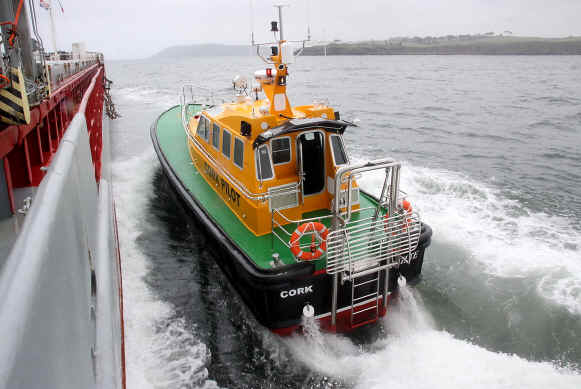
Self-righting-
a valuable feature for all weather pilots.
All
Safehaven Marines pilot boat designs are inherently self righting by virtue of
the superstructures volume and buoyancy, it being impossible to keep the hull
floating upside down. The stability curve should be positive, or at least close
to positive right through 180 degrees, this is often difficult to achieve due to
a pilot boats wide side decks, and there can be a soft spot around 100 degrees,
however this is somewhat academic, as in a real life roll over situation, any
force enough to roll her to this angle will roll her right over, or roll her
back as the wave passes through. A roll over event as we have seen from our
righting trials is quite a violent event, and pilots and crew would have to be
wearing seat belts to avoid injury. Self righting is of course dependant on the
vessel maintaining watertight integrity, and to achieve this numerous special
design features need to be incorporated. But
for Ports where pilots have to operate in dangerous
sea areas in all weathers, such as across bars, or where tidal influence may
create exceptional sea states, self righting is a valuable safety net for the
pilots and crew.
